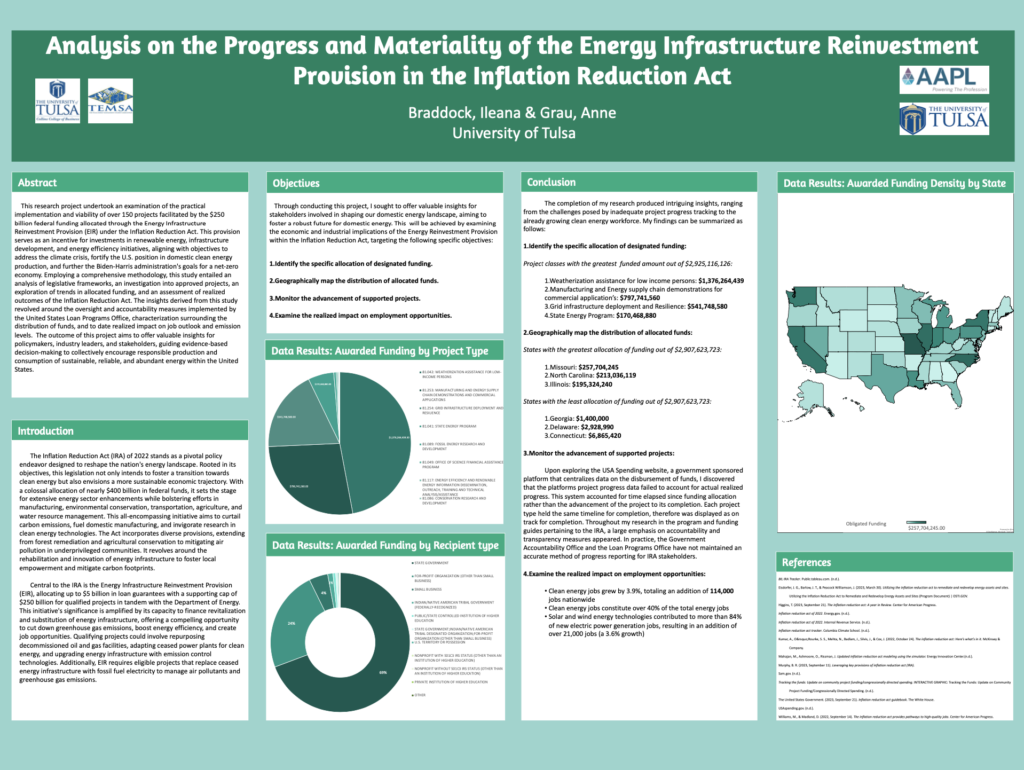By Ileana Braddock and Grau Anne
Abstract
This research project undertook an examination of the practical implementation and viability of over 150 projects facilitated by the $250 billion in federal funding allocated through the Energy Infrastructure Reinvestment Provision (EIR) under the Inflation Reduction Act. This provision serves as an incentive for investments in renewable energy, infrastructure development, and energy efficiency initiatives, aligning with objectives to address the climate crisis, fortify the U.S. position in domestic clean energy production, and further the Biden-Harris administration’s goals for a net-zero economy. Employing a comprehensive methodology, this study entailed an analysis of legislative frameworks, an investigation into approved projects, an exploration of trends in allocated funding, and an assessment of realized outcomes of the Inflation Reduction Act. The insights derived from this study revolved around the oversight and accountability measures implemented by the United States Loan Programs Office, characterization surrounding the distribution of funds, and to date realized impact on job outlook and emission levels. The outcome of this project aims to offer valuable insights for policymakers, industry leaders, and stakeholders, guiding evidence-based decision-making to collectively encourage responsible production and consumption of sustainable, reliable, and abundant energy within the United States.
Introduction
The Inflation Reduction Act (IRA) of 2022 stands as a pivotal policy endeavor designed to reshape the nation’s energy landscape. Rooted in its objectives, this legislation not only intends to foster a transition towards clean energy but also envisions a more sustainable economic trajectory. With a colossal allocation of nearly $400 billion in federal funds, it sets the stage for extensive energy sector enhancements while bolstering efforts in manufacturing, environmental conservation, transportation, agriculture, and water resource management. This all-encompassing initiative aims to curtail carbon emissions, fuel domestic manufacturing, and invigorate research in clean energy technologies. The Act incorporates diverse provisions, extending from forest remediation and agricultural conservation to mitigating air pollution in underprivileged communities. It revolves around the rehabilitation and innovation of energy infrastructure to foster local empowerment and mitigate carbon footprints.
Central to the IRA is the Energy Infrastructure Reinvestment Provision (EIR), allocating up to $5 billion in loan guarantees with a supporting cap of $250 billion for qualified projects in tandem with the Department of Energy. This initiative’s significance is amplified by its capacity to finance the revitalization and substitution of energy infrastructure, offering a compelling opportunity to cut down greenhouse gas emissions, boost energy efficiency, and create job opportunities. Qualifying projects could involve repurposing decommissioned oil and gas facilities, adapting ceased power plants for clean energy, and upgrading energy infrastructure with emission control technologies. Additionally, EIR requires eligible projects that replace ceased energy infrastructure with fossil fuel electricity to manage air pollutants and greenhouse gas emissions.
Objectives
Through conducting this project, I sought to offer valuable insights to stakeholders involved in shaping our domestic energy landscape, aiming to foster a robust future for domestic energy. This will be achieved by examining the economic and industrial implications of the Energy Reinvestment Provision within the Inflation Reduction Act, targeting the following specific objectives:
- Identify the specific allocation of designated funding.
- Geographically map the distribution of allocated funds.
- Monitor the advancement of supported projects.
- Examine the realized impact on employment opportunities.
Conclusion
Completing my research produced intriguing insights, ranging from the challenges posed by inadequate project progress tracking to the already growing clean energy workforce. My findings can be summarized as follows:
- Identify the specific allocation of designated funding:
Project classes with the greatest funded amount out of $2,925,116,126:
- Weatherization assistance for low-income persons: $1,376,264,439
- Manufacturing and Energy supply chain demonstrations for commercial applications: $797,741,560
- Grid infrastructure deployment and Resilience: $541,748,580 4.State Energy Program: $170,468,880
2. Geographically map the distribution of allocated funds:
States with the greatest allocation of funding out of $2,907,623,723:
- Missouri: $257,704,245
- North Carolina: $213,036,119
- Illinois: $195,324,240
States with the least allocation of funding out of $2,907,623,723:
- Georgia: $1,400,000
- Delaware: $2,928,990
- Connecticut: $6,865,420
3. Monitor the advancement of supported projects:
Upon exploring the USA Spending website, a government sponsored platform that centralizes data on the disbursement of funds, I discovered that the platforms project progress data failed to account for actual realized progress. This system accounted for time elapsed since funding allocation rather than the advancement of the project to its completion. Each project type held the same timeline for completion, therefore was displayed as on track for completion. Throughout my research in the program and funding guides pertaining to the IRA, a large emphasis on accountability and transparency measures appeared. In practice, the Government Accountability Office and the Loan Programs Office have not maintained an accurate method of progress reporting for IRA stakeholders.
4. Examine the realized impact on employment opportunities:
• Clean energy jobs grew by 3.9%, totaling an addition of 114,000 jobs nationwide
• Clean energy jobs constitute over 40% of the total energy jobs
• Solar and wind energy technologies contributed to more than 84% of new electric power generation jobs, resulting in an addition of over 21,000 jobs (a 3.6% growth)

